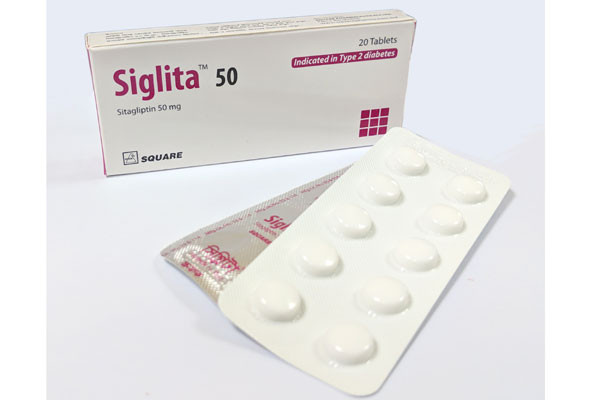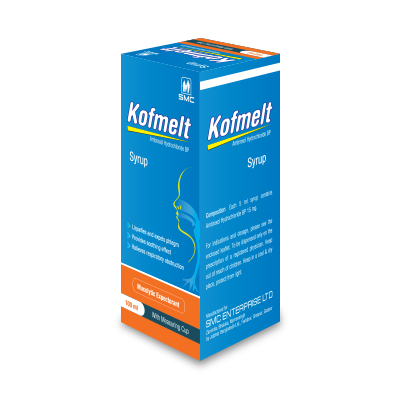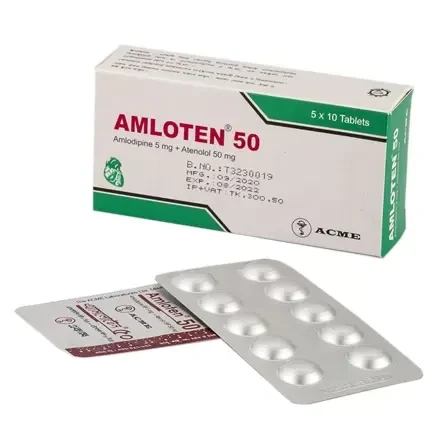

Siglita Tablet, Sitagliptin 50 mg
Inhouse product
-
৳11.40
৳12.00 -
৳42.75
৳45.00 -
৳16.63
৳17.50 -
৳2.14
৳2.25
Reviews & Ratings
Indications
Monotherapy and
Combination Therapy: Siglita is indicated
as an adjunct to diet and exercise to improve glycemic control in adults with
type 2 diabetes mellitus.
Important Limitations
of Use: Siglita should not
be used in patients with type 1 diabetes or for the treatment of diabetic
ketoacidosis, as it would not be effective in these settings. Siglita has not
been studied in patients with a history of pancreatitis. It is unknown whether
patients with a history of pancreatitis are at increased risk for the
development of pancreatitis while using Siglita.
* রেজিস্টার্ড চিকিৎসকের পরামর্শ মোতাবেক ঔষধ সেবন করুন'
Pharmacology
Sitagliptin is a DPP-4
inhibitor, which is believed to exert its actions in patients with type 2
diabetes by slowing the inactivation of incretin hormones. Concentrations of
the active intact hormones are increased by Sitagliptin, thereby increasing and
prolonging the action of these hormones. Incretin hormones, including
glucagon-like peptide-1 (GLP-1) and glucose-dependent insulinotropic
polypeptide (GIP), are released by the intestine throughout the day, and levels
are increased in response to a meal. These hormones are rapidly inactivated by
the enzyme, DPP-4. The incretins are part of an endogenous system involved in
the physiologic regulation of glucose homeostasis. When blood glucose
concentrations are normal or elevated, GLP-1 and GIP increase insulin synthesis
and release from pancreatic beta cells by intracellular signaling pathways
involving cyclic AMP. GLP-1 also lowers glucagon secretion from pancreatic
alpha cells, leading to reduced hepatic glucose production. By increasing and
prolonging active incretin levels, Sitagliptin increases insulin release and
decreases glucagon levels in the circulation in a glucose-dependent manner.
Sitagliptin demonstrates selectivity for DPP-4 and does not inhibit DPP-8 or DPP-9
activity in vitro at concentrations approximating those from therapeutic doses.
Dosage & Administration
The recommended dose
of sitagliptin is 50 mg twice a day and 100 mg once daily. Sitagliptin can be
taken with or without food.
* রেজিস্টার্ড চিকিৎসকের পরামর্শ মোতাবেক ঔষধ সেবন করুন'
Interaction
Effects of Siglita on
other Drugs: Siglita did not
meaningfully alter the pharmacokinetics of metformin, glyburide, simvastatin,
rosiglitazone, warfarin, or oral contraceptive.
Digoxin: Siglita slightly increases the mean of
Digoxin concentration. However, no dose adjustment of either drug is required.
Contraindications
History of a serious
hypersensitivity reaction to sitagliptin, such as anaphylaxis or angioedema.
Side Effects
The most common
adverse reactions include headache, upper respiratory tract infection and
nasopharyngitis. Hypoglycemia may occur in patients treated with the
combination to Siglita and sulfonylurea and add on to insulin.
Pregnancy & Lactation
Pregnancy Category B.
Reproduction studies have been performed in rats and rabbits. Because animal
reproduction studies are not always predictive of human response, this drug
should be used during pregnancy only if clearly needed. Sitagliptin is secreted
in the milk of lactating rats at milk to plasma ratio of 4:1. It is not known
whether sitagliptin is excreted in human milk. Because many drugs are excreted
in human milk, caution should be exercised when sitagliptin is administered to
a nursing woman.
Precautions & Warnings
If pancreatitis is
suspected, Siglita should promptly be discontinued and appropriate management
should be initiated.
Use in Patients with
Renal Insufficiency: Dosage adjustment is
recommended in patients with moderate or severe renal insufficiency and in
patients with ESRD requiring hemodialysis or peritoneal dialysis.
Use with medications
known to cause Hypoglycemia:
When Siglita is used in combination therapy dosage adjustment of sulfonylurea
or insulin may be required to reduce the risk of hypoglycemia.
Hypersensitivity
Reactions: There have been
post-marketing reports of serious hypersensitivity reactions in patients
treated with Siglita. These reactions include anaphylaxis, angioedema, and
exfoliative skin conditions including Stevens-Johnson syndrome. If a
hypersensitivity reaction is suspected, discontinue Siglita, assess for other
potential causes for the event, and institute alternative treatment for
diabetes.
Use in Special Populations
Pediatric Use: Safety and effectiveness of Siglita in
pediatric patients under 18 years of age have not been established.
Geriatric Use: Siglita is known to be substantially
excreted by the kidney. Because elderly patients are more likely to have
decreased renal function, care should be taken in dose selection in the
elderly, and it may be useful to assess renal function in these patients prior
to initiating dosing and periodically thereafter.
For patients with mild
renal insufciency: (CrCl <50 ml/min
or serum creatinine levels of <1.7 mg/DL in men and <1.5 mg/DL in women),
no dosage adjustment for Siglita is required.
For patients with
moderate renal insufciency:
(CrCl <30 to <50 mL/min, or serum creatinine levels of >1.7 to <3.0
mg/dL in men and >1.5 to <2.5 mg/dL in women), the dose of Siglita is 50
mg once daily.
For patients with
severe renal insufficiency:
(CrCl <30 mL/min or serum creatinine levels of >3.0 mg/dL in men and 2.5
mg/dL in women) or with end-stage renal disease (ESRD) requiring hemodialysis
or peritoneal dialysis, the dose of Siglita is 25 mg once daily. Siglita may be
administered without regard to the limiting of hemodialysis.
Overdose Effects
During controlled
clinical trials in healthy subjects, single doses of up to 800 mg Siglita were
administered. Maximal mean increases in QTc of 8.0 msec were observed in one
study at a dose of 800 mg Siglita, a mean effect that is not considered
clinically important. There is no experience with doses above 800 mg in
clinical studies. In Phase I multiple-dose studies, there were no dose-related
clinical adverse reactions observed with Siglita with doses of up to 600 mg per
day for periods of up to 10 days and 400 mg per day for up to 28 days.
In the event of an overdose, it is reasonable to employ the usual supportive
measures, e.g., remove unabsorbed material from the gastrointestinal tract,
employ clinical monitoring (including obtaining an electrocardiogram), and
institute supportive therapy as dictated by the patient's clinical status.
Siglita is modestly dialyzable. In clinical studies, approximately 13.5% of the
dose was removed over a 3- to 4-hour hemodialysis session. Prolonged
hemodialysis may be considered if clinically appropriate. It is not known if
Siglita is dialyzable by peritoneal dialysis.
Therapeutic Class
Dipeptidyl Peptidase-4
(DPP-4) inhibitor
Storage Conditions
Store below 25°C in a
dry place away from light. Keep the medicines in a safe place, out of the reach
of children. Do not use later than the date of expiry. To be dispensed only on
the prescription of a registered physician
Frequently Bought Products
Methigic Tablet., Methylprednisolone 16 mg
Myonil Tablet, Eperisone Hydrochloride 50 mg
D-Balance Capsule, Cholecalciferol [Vitamin D3] 20000 IU
Fona Plus Gel 10gm, Adapalene + Benzoyl peroxide 0.1%+2.5%
Product Queries (0)
Login Or Registerto submit your questions to seller
Other Questions
No none asked to seller yet
-
৳11.40
৳12.00 -
৳42.75
৳45.00 -
৳16.63
৳17.50 -
৳2.14
৳2.25










![D-Balance Capsule, Cholecalciferol [Vitamin D3] 20000 IU](https://skpharma.com.bd/public/uploads/all/ZQEOLUSfPiRWKBAjZEFmCdpCgHoASAMjwnjNvkjk.webp)

![Honeybas Syrup 100 ml bottle, Herbal cough syrup [Vasakarista]](https://skpharma.com.bd/public/uploads/all/pn2HDFQpzuf5lmsgeQ0cpDC7ieAWxguH3Wd5L0Vv.webp)




